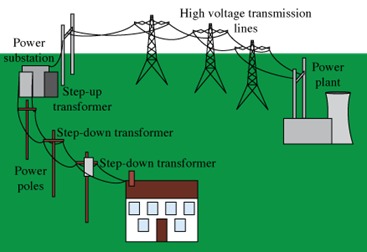ELECTRICAL GRID
Electrical Grid

[Figure 1]
These electric power towers carry high-voltage electric lines. The lines transmit electricity from power plants to homes like yours. The towers are a crucial part of the electrical grid.
What Is an Electrical Grid?
An electrical grid is the entire electrical system that generates, transmits, and distributes electric power throughout a region or country. A very simple electrical grid is sketched in the Figure below.

[Figure 2]
The electrical grid includes a power plant, transmission lines, and electric substations, all of which work together to provide alternating current to customers.
Power Plants
Electricity originates in power plants. They have electric generators that produce electricity by electromagnetic induction. In this process, a changing magnetic field is used to generate electric current. The generators convert kinetic energy to electrical energy. The kinetic energy may come from flowing water, burning fuel, wind, or some other energy source.
Transmission Lines
Transmission lines on big towers—like those in the opening photo above—carry high-voltage electric current from power plants to electric substations. Smaller towers and individual power poles carry lower-voltage current from electric substations to homes and businesses.
Electric Substations
Electric substations have several functions. Many substations distribute electricity from a few high-voltage lines to several lower-voltage lines. They have electric transformers, which use electromagnetic induction to change the voltage of the current. Some transformers increase the voltage; others decrease the voltage. In the Figure below, you can see how both types of transformers are used in an electrical grid.

[Figure 3]
· A step-up transformer increases the voltage of the current as it leaves the power plant. After the voltage has been increased, less current travels through the high-voltage power lines. This reduces the amount of power that is lost due to resistance of the power lines.
· A step-down transformer decreases the voltage of the current so it can be distributed safely to businesses and homes. A high-voltage power line may have 750,000 volts, whereas most home circuits have a maximum of 240 volts. Therefore, one or more step-down transformers are needed to decrease the voltage of current before it enters homes.
Q: Assume that a home needs a 14-volt circuit for a light and a 120-volt circuit for a microwave oven. If the main power line entering home has 240 volts, what can you infer about the home’s electrical system?
A: The home’s electrical system must have step-down transformers that lower the voltage for some of the home’s circuits.
Launch the Power Lines simulation below to help you visualize how high-voltage power lines carry electricity:
Summary
· The electrical grid is the entire electrical system that generates, transmits, and distributes electric power throughout a region or country. It includes power plants, transmission lines, and electric substations.
· Power plants are where electric power originates. They have electric generators that generate electric current through electromagnetic induction.
· Transmission lines carry electric current from power plants to substations and from substations to homes and other places where electric power is needed.
· Electric substations have step-up or step-down transformers to increase or decrease the voltage of current as needed.
Review
1. Identify the components of an electrical grid.
2. What is the source of power in an electrical grid?
3. Explain why an electrical grid must have electric transformers.
4. If lightning strikes a transformer, it will cause power outages. Which lightning strike is likely to affect the most electric power customers: a strike to a step-down transformer on an electric pole or a strike to a step-down transformer in an electric substation?